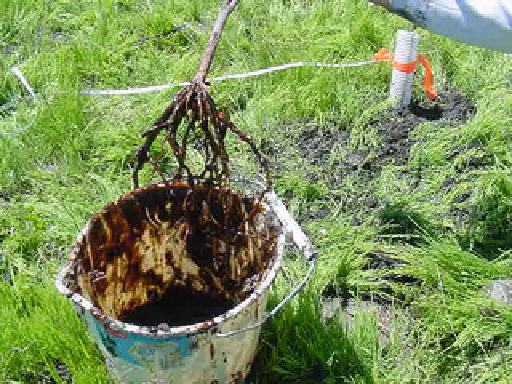Environmental Engineering Reference
In-Depth Information
Fig. 8.3
Initial planting of five
rows of hybrid poplar whips
during phase one, November
1998, Charleston, South Carolina.
Monitoring wells, such as shown
in the foreground and far
background, were installed within
and outside the planted area to
assess hydrologic control of
groundwater by phytoremediation
(Photograph by author).
groundwater flow from the former MGP site to beneath the
planted area. Phase two consisted of installing 100, 6-ft
(1.8 m) bare-root cuttings in March 2000 on the eastern
half of the planted area. The cuttings installed were
P.
deltoides x P. nigra
(OP-367). This hybrid, considered to
be more salt tolerant, was selected because groundwater
beneath the eastern part of the site contains higher amounts
of salinity due to the proximity of the saline Cooper River.
For both planting phases, a mycorrhizal fungal inoculant
was mixed with water and used to coat the cutting or bare
roots before installation in the ground (MycorTree
™
root
dip, Plant Health Care, Pittsburgh, PA) (Fig.
8.4
). To provide
for erosion control during the establishment of a canopy of
the cuttings, a ground cover consisting of a mixture of
southern common alfalfa (
Medicago sativa
) and coastal
Bermuda grass (
Cynodon dactylon
) was seeded at a rate
equivalent to 20 lb/acre.
A weather station was installed at the site in December
1998 after initial tree planting to collect data that would be
used to evaluate which measured parameter, such as solar
radiation, air temperature, and relative humidity, more
strongly influenced the uptake of groundwater by the trees.
The weather station consists of sensors that measure precip-
itation (Sutron Model 5600-04207), air temperature (R.M.
Young Company), leaf temperature (Pessl Instruments),
barometric pressure (R.M. Young Company), solar radiation
(LI-COR Corporation), relative humidity (R.M. Young
Company), and wind speed and wind direction (R.M.
Young Company). The measurements were taken from all
sensors at 15-m intervals, recorded on an adjacent data
collection platform (Sutron 8210 Data Recorder), and trans-
mitted by satellite to the USGS Water Science Center office
in Columbia, SC. The data collection platform and all
sensors were powered by 12-V marine batteries recharged
Fig. 8.4
Inoculation of bare root cutting hybrid poplars installed at the
Charleston, SC, former MGP site, with a slurry of endo- and ecto-
mycorrhizae prior to planting (Photograph by author).
by 40-Watt (W) solar panels (Solarex). The weather station
was used to provide data to estimate
ET
p
rates based on the
Penman equation (Penman 1948) as well as to compute
changes in
VPD
.
8.3.1 Potential Evapotranspiration Relative
to Groundwater Discharge
To evaluate the effect of the trees installed at the site in
Charleston, SC on groundwater, comparison of estimated
ET
p
with estimated groundwater discharge was performed.
The site parameters used as part of the
ET
p
assessment are
presented in Table
8.2
.


Search WWH ::

Custom Search